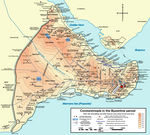Istanbul Postal Museum
2000 establishments in TurkeyBuildings and structures in IstanbulFatihFirst Turkish National architectureGovernment buildings completed in 1909 ... and 8 more
Museums established in 2000Museums in IstanbulOffice buildings completed in 1909Ottoman architecture in IstanbulPhilatelic museumsPostal museumsPostal system of TurkeyTelecommunications in Turkey

The Istanbul Postal Museum, aka PTT Museum Istanbul (Turkish: PTT İstanbul Müzesi), is a postal museum dedicated to the historical development of mail and telecommunication services in the Ottoman Empire and Turkey, exhibiting related equipment and instruments as well as a collection of postage stamps. It was established in 2000 by the Turkish Post, and is situated inside the Grand Post Office building at Sirkeci quarter of Fatih district in Istanbul, Turkey.
Excerpt from the Wikipedia article Istanbul Postal Museum (License: CC BY-SA 3.0, Authors, Images).Istanbul Postal Museum
Büyük Postane Caddesi, Istanbul
Geographical coordinates (GPS) Address Nearby Places Show on map
Geographical coordinates (GPS)
| Latitude | Longitude |
|---|---|
| N 41.01485 ° | E 28.97361 ° |
Address
Ayhan usta
Büyük Postane Caddesi
34112 Istanbul
Türkiye
Open on Google Maps









